Welcome to our feline-focused feature where we’ll explore the top cat breeds that thrive as outdoor cats. Outdoor cats enjoy a sense of freedom, revel in natural stimulation, and often lead dynamic and adventurous lives.
But not all cat breeds are equally suited to the rigors of the great outdoors. Safety, health, and temperament are key factors when considering whether a cat can live happily outside. In this article, we will introduce you to some of the best cat breeds for anyone looking to share their open-air lifestyle with a four-legged companion.
From the rugged Maine Coon to the agile Abyssinian, each of these breeds has qualities that make them fantastic outdoor pals. Let’s dive into the world of these intrepid explorers and find the perfect outdoor companion for your lifestyle.
10. Korat

Hailing from Thailand, the Korat is a cat breed known for its striking silver-blue coat and affectionate, playful nature. Korats are intelligent and loyal companions that form strong bonds with their families.
When it comes to outdoor spaces, these cats can be quite territorial and enjoy the opportunity to explore and patrol their domain. However, due to their rarity and the deep attachment they form with their humans, it is advisable to provide a secure outdoor environment for Korats.
This can be achieved by creating a cat-friendly garden, where they can climb and investigate safely without the risks associated with open, unsupervised territories.
Another aspect to consider is the Korat’s athletic build and keen senses, which make it well-suited for an active outdoor lifestyle, provided that safety measures are in place. When allowing your Korat to venture into the outdoors, ensure it is microchipped and wears a collar with an ID tag, so that it can be easily identified and returned home if it wanders too far.
Moreover, regular health check-ups and vaccinations are essential to keep your Korat in good shape, ready for its next safe outdoor adventure.
9. Savannah
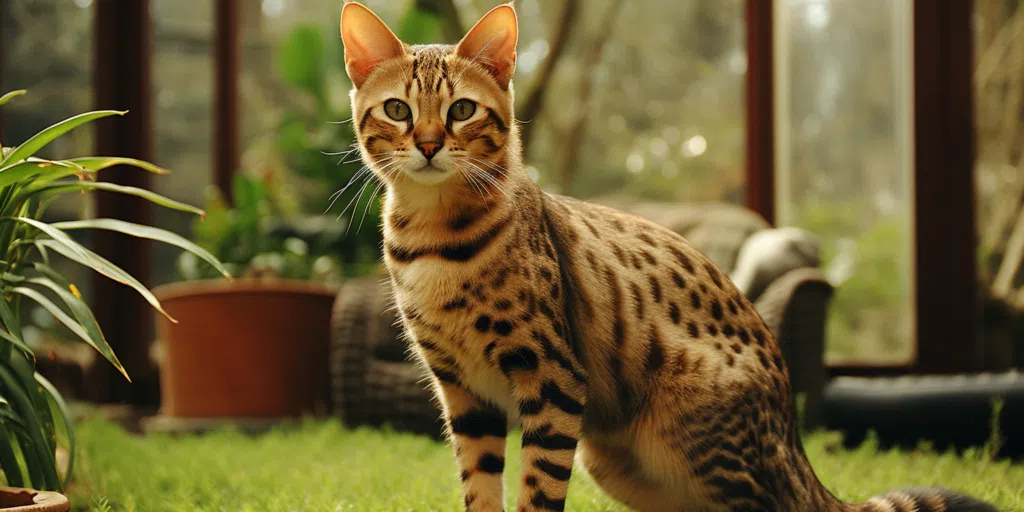
Savannahs are among the larger breeds of domestic cats, known for their exotic appearance that resembles that of their wild ancestors—the African servals. Their large size, high energy levels, and exceptional leaping abilities make them well-suited for outdoor environments.
Savannahs tend to enjoy the freedom of space where they can express their natural behaviors like leaping, running, and climbing. However, given their rarity and value, it’s vital to ensure that your Savannah can enjoy the outdoors without the risk of theft or getting lost, using enclosures or cat-proof fencing.
Additionally, Savannahs are inquisitive and often fearless, traits that could potentially lead them into trouble outdoors. Keeping them in an enriched environment with plenty of vertical space for climbing and spaces to explore can satisfy their need for adventure while keeping them safe.
It is also important to engage in regular, vigorous play to keep their minds stimulated and their bodies exercised. Socialization with other pets and humans from a young age can help manage their strong hunting instincts when they are outside.
8. American Bobtail
The American Bobtail is known for its wild appearance, coupled with a friendly and interactive personality. This breed has a reputation for its adaptability and enjoyment of family life, including participation in outdoor activities.
They carry a natural fascination with hiking and exploring, which can be fulfilled safely within cat patios (catios) or on supervised walks on a leash. American Bobtails are typically hearty and robust cats, but allowing them unsupervised reign over outdoor areas can still pose threats such as accidents or confrontations with other animals.
American Bobtails’ unique appearance, with their short tails and strong, muscular bodies, offers a visual cue to their ability to handle themselves in varied environments. Yet their sociable disposition makes them targets for theft or prone to roaming.
It’s crucial to always keep an American Bobtail’s well-being in mind by offering opportunities for safe outdoor exploration, including secure backyard escapes or adventure harness training, which can provide stimulation and exercise in a controlled manner.
7. Russian Blue
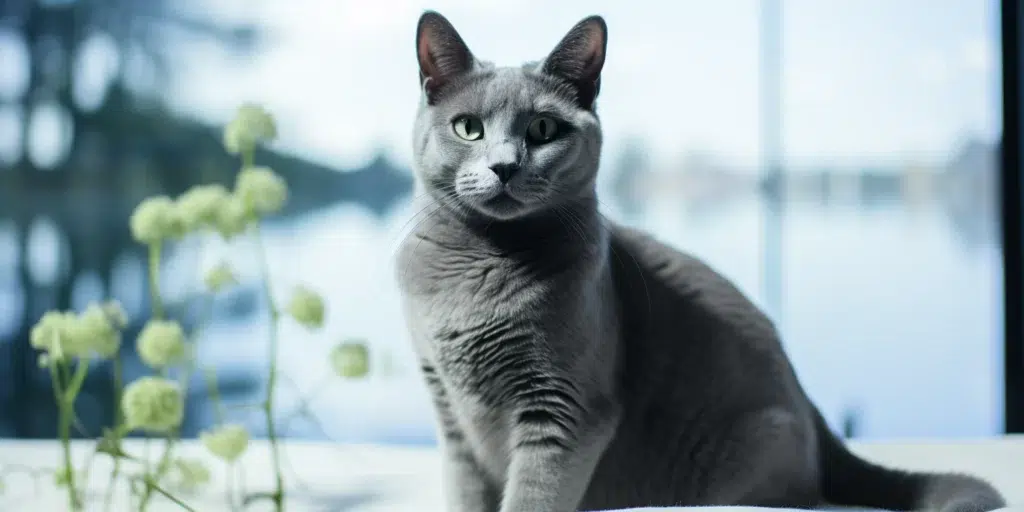
The Russian Blue is a breed revered for its elegant look and plush, silvery coat. They are also known for their gentle, reserved nature and can often be shy around strangers. Russian Blues are highly perceptive and enjoy a consistent routine, which makes a controlled outdoor experience that minimizes stress ideal for them.
When it comes to outdoor adventures for this breed, a protected and quiet garden space can provide the enrichment they need without overwhelming their sensitive temperament.
Moreover, Russian blues are intelligent and playful, requiring stimulation to stay active and healthy. Providing a safe outdoor environment with puzzles and toys can cater to these needs. It’s also important to consider their dense coat, which serves as excellent insulation—a trait that can be beneficial during cooler outings.
However, ensure to offer shade and plenty of fresh water to keep your Russian Blue hydrated and content while enjoying the fresh air and sun.
6. Abyssinian
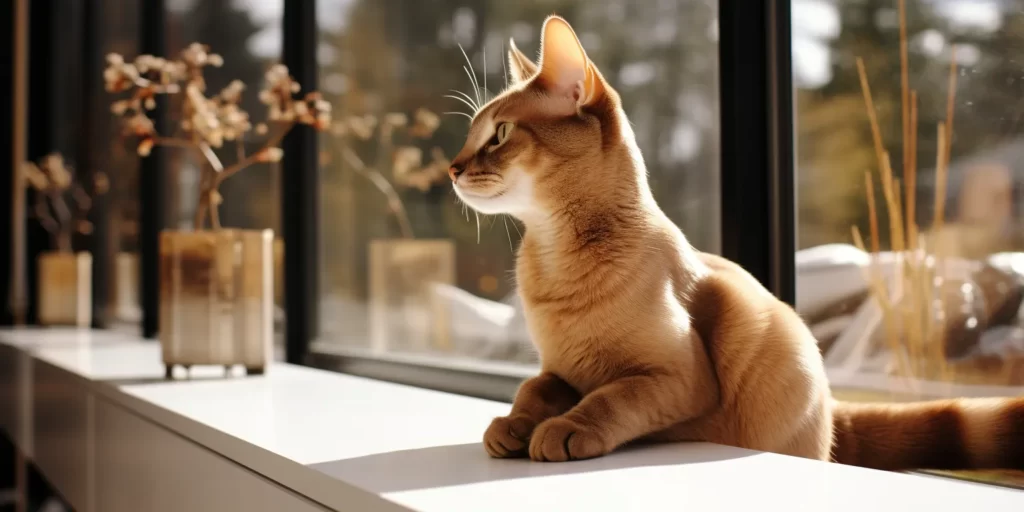
Abyssinians are often hailed as one of the most active and playful cat breeds. Their sleek, lean bodies and a vibrant personality make them perfect candidates for outdoor play—under vigilant supervision, of course.
This breed has an insatiable curiosity, which can be satisfied by creating a stimulating outdoor environment. This could include climbing structures, interactive toys, and spaces designed for exploration.
However, care must be taken to ensure that the outdoor space is secure, as Abyssinians’ adventurous spirit may lead to them straying too far from home if given the chance.
The Abyssinian’s love of heights and exploration can be nurtured through the provision of cat trees and elevated platforms in a safe outdoor area. Keeping their agility and need for physical activity in mind, you can engage them with training for agility courses or interactive games that utilize their natural dexterity.
Remember that with their sociable nature, Abyssinians can benefit from the mental stimulation that the controlled outdoor environment provides, while safeguarding them from the dangers that the world beyond the backyard may present.
5. European Shorthair
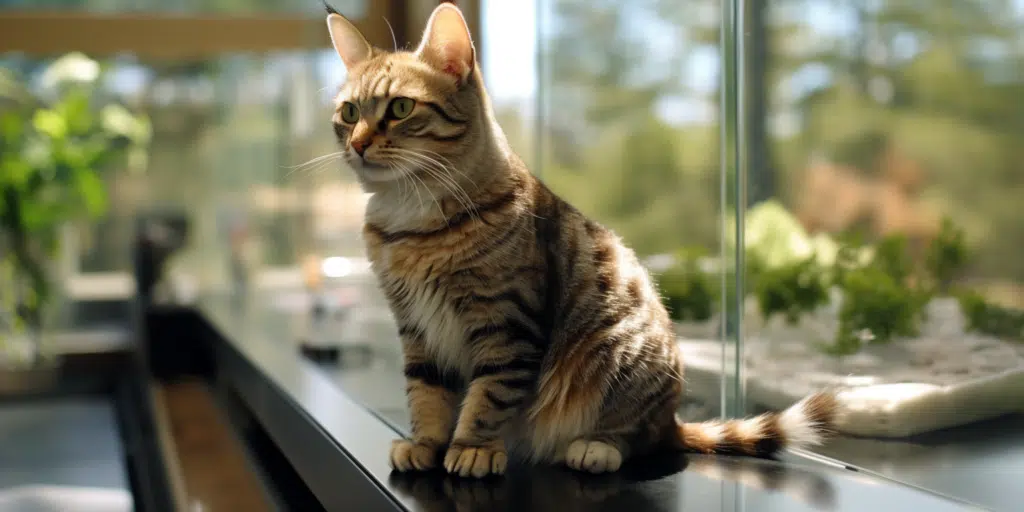
The European Shorthair, often celebrated for its robust nature and amiable character, is a breed that can enjoy outdoor spaces with proper supervision. Their adaptable personality makes them suited to a variety of environments, yet like any domestic cat, they should not be left to wander unsupervised.
Creating a safe, enclosed space for your European Shorthair that stimulates their playful instincts can provide the best of both worlds—protection from external dangers and the joy of outdoor activity.
With regular exercise crucial to the European Shorthair’s health, an outdoor space fitted with scratching posts, climbing frames, and a variety of toys can help keep these cats happy and fit.
Ensuring that the outdoor area is escape-proof is a responsibility that should not be taken lightly, as their curiosity and explorative nature might otherwise lead them into trouble.
Additionally, their dense coat requires minimal grooming, making it relatively easier for them to maintain their hygiene after an outdoor excursion.
4. Bengal
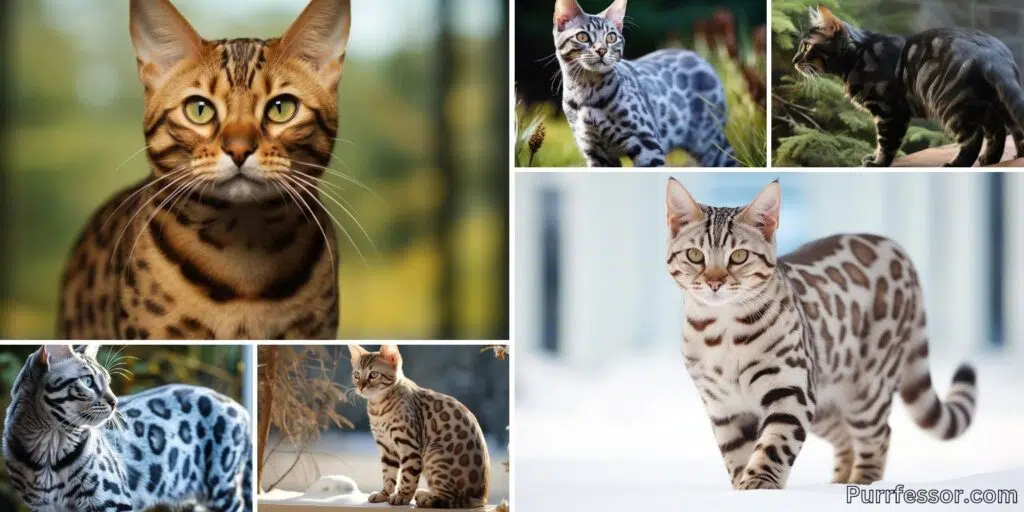
The Bengal is a special breed that stands out with its stunning wild-like appearance and a dynamic, lively personality. Bengals are known for their love of water and their desire to climb, making them well-suited for safe, enriched outdoor environments.
Specifically, they excel in areas where they can perform their acrobatic jumps and explore water features under a watchful eye. Due to their high intelligence and active nature, a Bengal without an adequate outlet for its energy can become bored and develop unwanted behaviors.
To keep a Bengal entertained, incorporating elements such as running water, high perches, and safe climbing structures is ideal in their outdoor play areas. This breed requires a great deal of interactive play and mental challenges to satisfy its instincts.
It is also crucial to ensure that any outdoor experience for your Bengal is well-contained, as their valuable lineage and curious disposition can lead them to stray far from home or into potential danger.
3. Manx
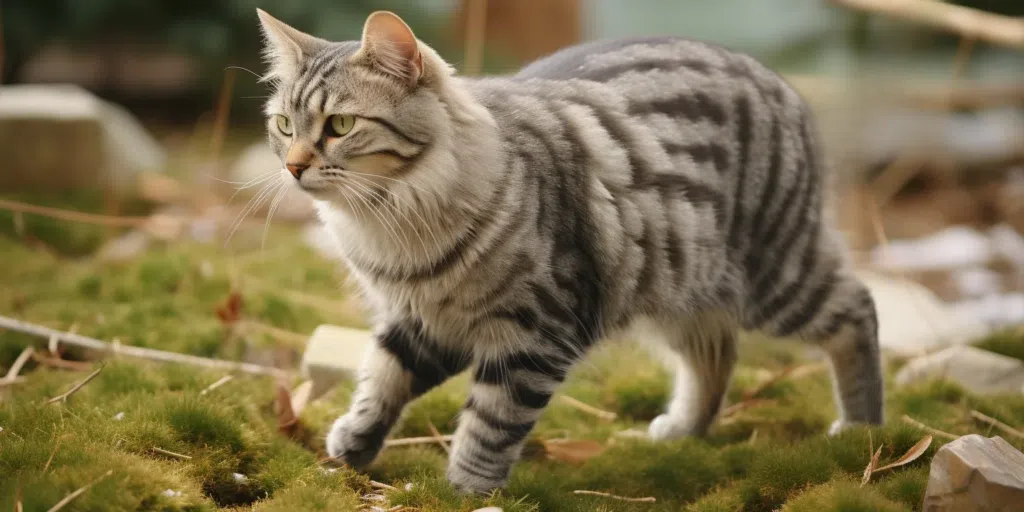
The Manx cat, famously known for its taillessness, is a breed rich in history and character. Originating from the Isle of Man, this breed is recognized for its sturdiness and amiableness.
Manx cats often enjoy the stimulation that the outdoors provides; however, they should have access to it in a secure manner. They can blossom in an environment where there is plenty to explore but remain safe from the risks that unrestricted outdoor access would impose.
When setting up an outdoor space for a Manx, consider their strong hunting instincts and design spaces that include opportunities to pounce and stalk in play.
Enclosed gardens or catios are ideal for providing Manx cats with fresh air and sunlight while keeping them within the boundaries of your property. Remember to keep their vaccinations up to date, as even protected outdoor environments can expose them to pests and parasites.
2. Maine Coon
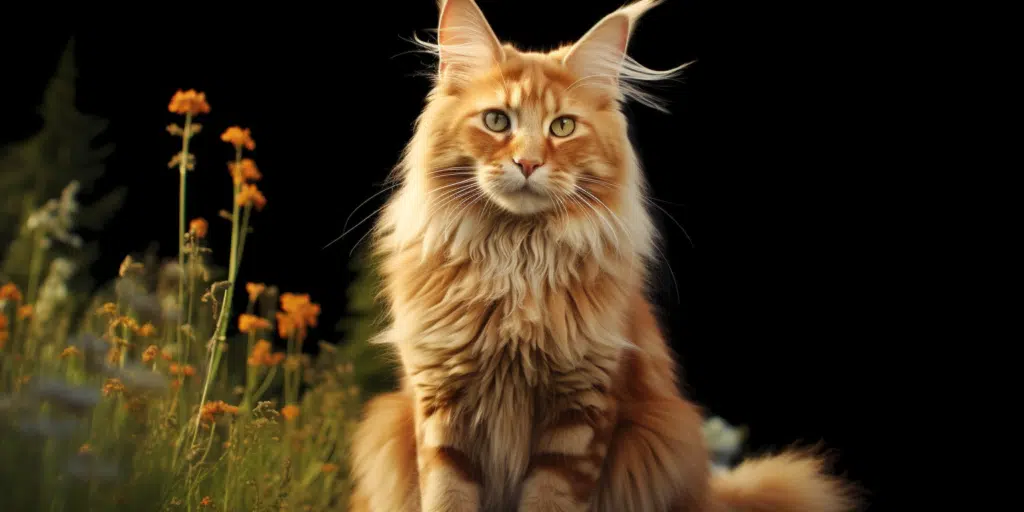
Maine Coons are one of the largest and most sociable cat breeds, renowned for their majestic appearance and friendly personalities. With origins in the harsh climates of New England, they possess a rugged constitution and are often quite adventurous.
A sizable and safe outdoor space accustoms them to ample exercise and sensory experiences, which are vital for their physical and mental well-being.
However, as with all breeds, the benefits of outdoor exploration should be weighed against potential hazards, and safety should always be the top priority.
Given their impressive size and intelligence, Maine Coons require a considerable amount of space to roam. Nonetheless, it is crucial to create a secure outdoor area that protects them from dangers such as predators, cars, and toxins.
Equipped with a hefty and water-resistant coat, Maine Coons can tolerate cooler temperatures, but always ensure that they have easy access to shelter and are not exposed to extreme conditions.
1. Norwegian Forest
The Norwegian Forest Cat boasts a history as rugged and hearty as the terrain of its Scandinavian homeland. This breed possesses a sturdy build and a thick, water-repellent coat, making it naturally suited for the outdoors.
Norwegian Forest Cats often enjoy climbing and surveying their territory from high vantage points, but it’s essential to provide them with secure outdoor access. Their robustness does not spare them from the threats that the outside world poses to domestic cats.
Creating a cat-friendly landscape with tall, sturdy climbing structures and sheltered resting spots can encourage your Norwegian forest cat to enjoy the fresh air while minimizing risks.
Additionally, this breed’s luxurious double coat requires regular grooming to maintain its condition, particularly during shedding seasons.
Although the robust Norwegian Forest Cat is an adept hunter, they should be kept safe from the very prey they may pursue, as well as from other dangers of the wild.
Why It’s Not Ideal to Have Domestic Cats as Outdoor Pets
When considering the wellbeing of our feline friends, it’s important to recognize why keeping domestic cats as outdoor pets is not the most ideal choice. While the image of a cat freely roaming the outdoors may seem natural and healthy, the reality is that there are numerous risks associated with this lifestyle.
Outdoor cats are exposed to a variety of dangers that indoor cats are shielded from. They face the threat of traffic, which can lead to accidents and injuries. Cats are also at risk of encountering predators or getting into fights with other animals, potentially leading to severe injuries or the transmission of diseases like FIV (feline immunodeficiency virus) and FeLV (feline leukemia virus). Additionally, outdoor cats are at a higher risk of ingesting poisons or harmful substances, either through poisoned baits or accidental ingestion of toxic plants or chemicals.
Moreover, outdoor cats can have a significant negative impact on local wildlife, particularly birds. Cats are natural hunters, even when well-fed at home, and their hunting instincts can lead to a decrease in the population of native species. Furthermore, the outdoor lifestyle increases the chances of cats getting lost or stolen, which can be a heartbreaking experience for both the pet and the owner. Considering these risks, it is crucial to ensure that if a cat does spend time outdoors, it is done in a controlled and safe manner, preferably in a secure garden or through the use of a cat-proof fencing system.
Conclusion
While many cats have an innate desire to explore and enjoy the outdoors, it’s crucial to prioritize their safety above all else. The breeds mentioned above each have unique characteristics that can make them suitable for spending time outside, but they all share the common need for a secure outdoor environment.
By mindfully creating a safe space for your cat to experience nature, whether through a fully enclosed garden, a catio, or supervised outings, you can provide them with the joys of outdoor life without exposing them to its many dangers.
Always err on the side of caution and ensure your beloved cats can enjoy the best of both worlds—a natural playground and the comfort of a protected home.